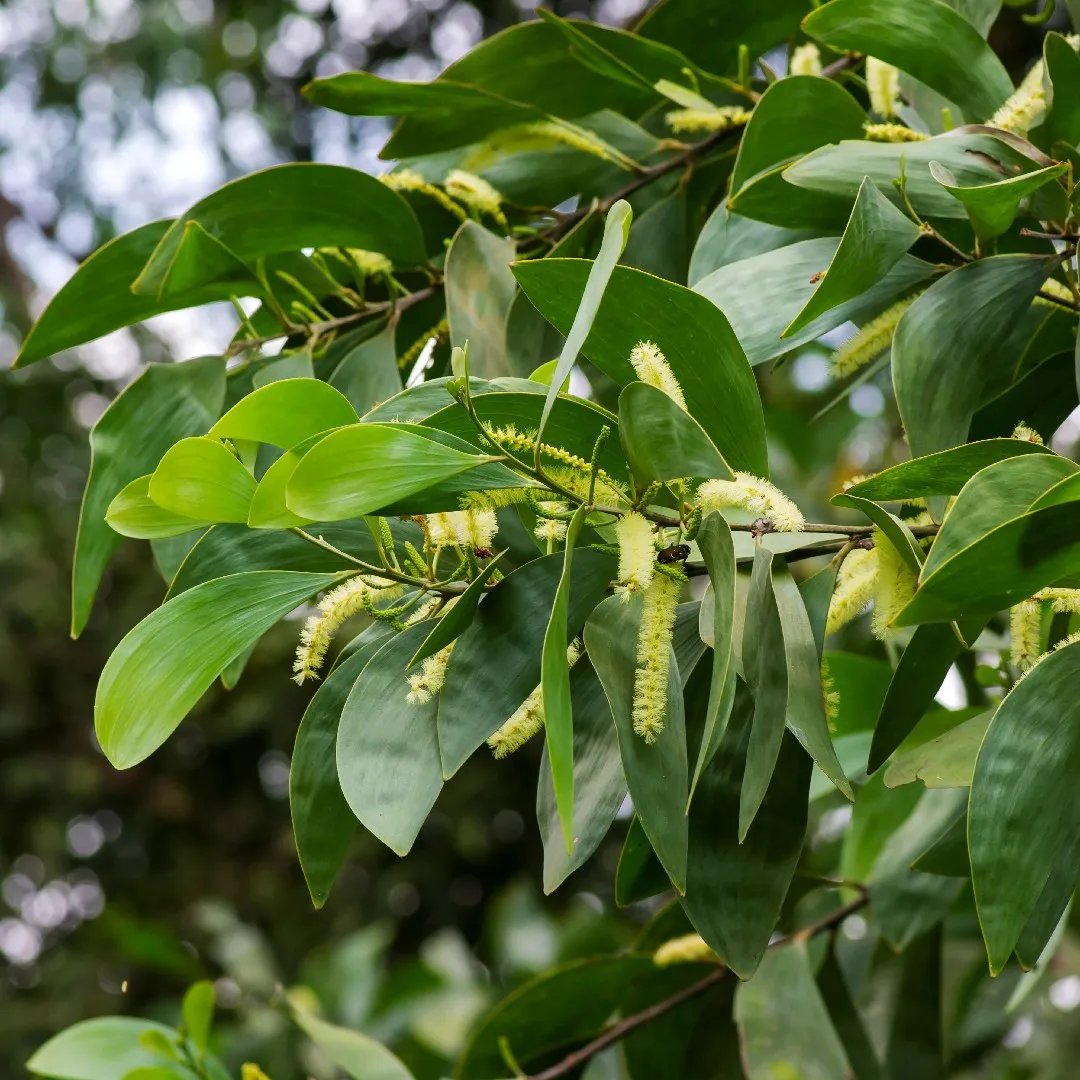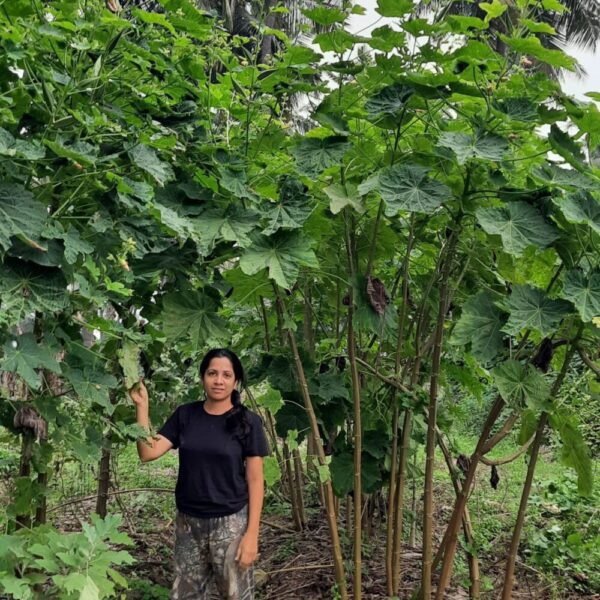Australian Rosewood Acacia Cracicarpa tree seeds
Australian Rosewood Acacia Cracicarpa tree seeds
Quantity: 3 grams
Planting Acacia Cracicarpa tree organic seeds is easy when you follow the right steps. Here’s how to get started:
- Soak the Australian Rosewood Acacia Cracicarpa tree seeds: To enhance germination, soak the seeds in warm water for 12–24 hours before planting. This softens the seed coat and encourages faster germination.
- Prepare the Soil: Acacia Cracicarpa prefers well-drained soil, ideally sandy, loamy, or slightly acidic soil with a pH between 6.0 and 7.5.
- Planting: Plant the Australian Rosewood Acacia Cracicarpa tree seeds about 1 inch deep in soil. If you’re planting multiple seeds, space them 3–5 feet apart to allow for proper growth.
- Watering and Care: Keep the soil consistently moist until the seeds germinate. Once the tree is established, it requires minimal watering and can tolerate dry conditions.
- Pruning: Prune the tree as necessary to maintain its shape and remove dead or damaged branches.
Why Buy from Hoogaseeds.com?
When you purchase organic Acacia Cracicarpa seeds from Hoogaseeds.com, you’re choosing quality and sustainability. Here’s why our customers trust us:
- Premium Organic Seeds: Our Australian Rosewood Acacia Cracicarpa tree seeds are carefully selected to ensure you receive the highest quality, non-GMO, and organic seeds available.
- Fast and Secure Shipping: We provide quick and safe shipping, so your seeds arrive in excellent condition and ready for planting.
- Expert Support: Our team of gardening experts is available to assist you with any questions or advice you may need as you grow your Acacia Cracicarpa tree.
Order Your Organic Acacia Cracicarpa Seeds Today!
Whether you’re looking to add beauty to your landscape, improve soil health, or grow valuable timber, the Australian Rosewood (Acacia Cracicarpa) is a fantastic tree to grow. Buy organic Acacia Cracicarpa seeds from Hoogaseeds.com today and start cultivating this stunning, multi-purpose tree in your garden or farm!
Australian Rosewood Acacia Cracicarpa tree seeds
Australian Rosewood Acacia Cracicarpa tree seeds
Buy Organic Australian Rosewood Acacia Cracicarpa Tree Seeds at Hoogaseeds.com
Looking to grow the unique and beautiful Australian Rosewood (Acacia Cracicarpa)? At Hoogaseeds.com, we offer premium-quality organic Acacia Cracicarpa tree seeds that are perfect for gardeners, landscapers, and agroforestry enthusiasts. Our Australian Rosewood Acacia Cracicarpa seeds are sourced with care to ensure high germination rates and healthy growth, so you can cultivate this remarkable tree with ease.
What is Acacia Cracicarpa (Australian Rosewood)?
Acacia Cracicarpa, commonly known as Australian Rosewood, is a striking and fast-growing tree native to the northern regions of Australia. Known for its stunning golden flowers, unique fragrant scent, and elegant appearance, this tree is a popular choice for landscaping and ecological restoration projects. It thrives in a variety of climates, making it an excellent choice for both ornamental and practical applications.
The Australian Rosewood Acacia Cracicarpa is also valued for its hard, dense timber and its ability to improve soil quality, making it a great option for sustainable agriculture and reforestation efforts.
Why Choose Organic Acacia Cracicarpa Seeds?
At Hoogaseeds.com, we provide organic Acacia Cracicarpa tree seeds that allow you to grow this beautiful tree in an eco-friendly, sustainable way. Here are a few reasons why our seeds stand out:
- 100% Organic: Our Acacia Cracicarpa seeds are non-GMO and grown without synthetic chemicals or fertilizers, ensuring that your garden remains free from harmful pesticides and herbicides.
- High Germination Rate: We carefully select our seeds for their superior germination rates, giving you the best chance to successfully grow healthy, strong trees.
- Versatility and Low Maintenance: This tree is adaptable to a range of soil types and is relatively drought-tolerant once established, making it a great choice for water-wise gardens.
- Aesthetic and Functional: Beyond its beauty, the Australian Rosewood is a valuable tree in ecological restoration, agroforestry, and landscaping projects.
Benefits of Growing Acacia Cracicarpa Tree
- Aesthetic Beauty: The Australian Rosewood produces striking clusters of bright yellow flowers that add a splash of color and attract pollinators like bees and butterflies. Its fine foliage and overall shape make it an attractive addition to any landscape.
- Durable Timber: The wood of Acacia Cracicarpa is dense, durable, and resistant to decay, making it a valuable resource for crafting furniture, construction, and other wood products.
- Soil Fertility: As a nitrogen-fixing tree, Acacia Cracicarpa improves soil quality by enriching it with nitrogen, which is beneficial for nearby crops and plants.
- Drought Tolerance: Once established, Acacia Cracicarpa is drought-tolerant, making it a low-maintenance option for arid and semi-arid regions.
- Wildlife Support: The tree’s flowers attract bees, birds, and other pollinators, while its dense canopy provides shade and shelter for wildlife.
- Erosion Control: Its strong root system helps prevent soil erosion, making it ideal for stabilizing land in areas prone to erosion.
How to Plant Organic Acacia Cracicarpa Seeds
Planting Acacia Cracicarpa tree organic seeds is easy when you follow the right steps. Here’s how to get started:
- Soak the Australian Rosewood Acacia Cracicarpa tree seeds: To enhance germination, soak the seeds in warm water for 12–24 hours before planting. This softens the seed coat and encourages faster germination.
- Prepare the Soil: Acacia Cracicarpa prefers well-drained soil, ideally sandy, loamy, or slightly acidic soil with a pH between 6.0 and 7.5.
- Planting: Plant the Australian Rosewood Acacia Cracicarpa tree seeds about 1 inch deep in soil. If you’re planting multiple seeds, space them 3–5 feet apart to allow for proper growth.
- Watering and Care: Keep the soil consistently moist until the seeds germinate. Once the tree is established, it requires minimal watering and can tolerate dry conditions.
- Pruning: Prune the tree as necessary to maintain its shape and remove dead or damaged branches.
Why Buy from Hoogaseeds.com?
When you purchase organic Acacia Cracicarpa seeds from Hoogaseeds.com, you’re choosing quality and sustainability. Here’s why our customers trust us:
- Premium Organic Seeds: Our Australian Rosewood Acacia Cracicarpa tree seeds are carefully selected to ensure you receive the highest quality, non-GMO, and organic seeds available.
- Fast and Secure Shipping: We provide quick and safe shipping, so your seeds arrive in excellent condition and ready for planting.
- Expert Support: Our team of gardening experts is available to assist you with any questions or advice you may need as you grow your Acacia Cracicarpa tree.
Order Your Organic Acacia Cracicarpa Seeds Today!
Whether you’re looking to add beauty to your landscape, improve soil health, or grow valuable timber, the Australian Rosewood (Acacia Cracicarpa) is a fantastic tree to grow. Buy organic Acacia Cracicarpa seeds from Hoogaseeds.com today and start cultivating this stunning, multi-purpose tree in your garden or farm!
Australian Rosewood Acacia Cracicarpa tree seeds
| Weight | 30 g |
|---|---|
| Dimensions | 11 × 9 × 11 cm |







Reviews
There are no reviews yet.